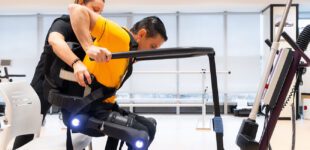August 21, 2018
Wheelchairs have come a long way in the last 50 years. Electric wheelchairs became popular for helping veterans of the Second World War, and represented a great stride forward in technology and accessibility at the time. But modern robotics stand to transform the wheelchair as we know it, greatly improving the lives of people with disabilities and those who rely on one for day-to-day tasks.
For example, take this wheelchair controlled by eye-gaze and how it would impact someone suffering from Amyotrophic Lateral Sclerosis (ALS). Suddenly, not being able to use a joystick is no longer a limiting factor.
Plus, in that study, by employing ultrasound and IR sensors, “no collisions between the wheelchair and the ambient environment were reported through the entire test,” and that research was published two years ago.
One of today’s most advanced wheelchairs is being pioneered by Ming Liu, IEEE Senior Member and Assistant Professor at Hong Kong University of Science and Technology.
See also Autonomous Vehicles Keep Important Deliveries Moving in the Age of COVID-19
Liu’s wheelchair is very much a robot, and can learn how to navigate complex environments: “When the robot moves around, it creates a 3-D representation of the environment, and then the robot will analyze this map so that it knows where the difficult parts are and how to transform itself so it can automatically move from point A to point B,” says Liu.
How a Robotic Wheelchair Helps People with Disabilities
The wheelchair does, quite literally, transform itself. As you can see in the video, elements of the chair can adjust automatically to allow it to go up and down stairs without requiring any user input. “The adaptation to use this wheelchair will be quite handy and very easy,” he says.
Vehicular robots are making life better for disabled children, too. Assistive technologies, like this vehicle described in a recent IEEE Xplore paper, have the potential to bring together “able bodied and disabled children to participate and cooperate in something that involves sharing and taking turns.”
“I think healthcare robots will be widely used in the next 5-10 years,” says Liu. “There are still some challenges we need to overcome; for example, society needs to accept healthcare robots, and be educated that humans can coexist with robotic systems and that they’re safe to use.”
“It is no surprise that in the time of COVID-19 we are thinking through artificial devices that can have physical interaction with people,” adds IEEE Senior Member and IEEE Engineering in Medicine and Biology Society member Jim Patton. “Robots are tireless, can measure very accurately, and can of course do very interesting things that capture the imagination and cannot otherwise be done using human contact and interaction. We are using artificial devices as physical tools more and more each day in not just rehabilitation but in transportation, mobility and telehealth.”
Interested in learning more about robots and healthcare? Check out EMBS.org for workshops, events and lectures on the subject.






 Liquid Infrastructure: Our Planet's Most Precious Resource
Liquid Infrastructure: Our Planet's Most Precious Resource The Impact of Technology in 2025
The Impact of Technology in 2025 Quantum and AI: Safeguards or Threats to Cybersecurity?
Quantum and AI: Safeguards or Threats to Cybersecurity? Why AI Can't Live Without Us
Why AI Can't Live Without Us Bits, Bytes, Buildings and Bridges: Digital-Driven Infrastructure
Bits, Bytes, Buildings and Bridges: Digital-Driven Infrastructure Impact of Technology in 2024
Impact of Technology in 2024 Emerging AI Cybersecurity Challenges and Solutions
Emerging AI Cybersecurity Challenges and Solutions The Skies are Unlimited
The Skies are Unlimited Smart Cities 2030: How Tech is Reshaping Urbanscapes
Smart Cities 2030: How Tech is Reshaping Urbanscapes Impact of Technology 2023
Impact of Technology 2023 Cybersecurity for Life-Changing Innovations
Cybersecurity for Life-Changing Innovations Smarter Wearables Healthier Life
Smarter Wearables Healthier Life Infrastructure In Motion
Infrastructure In Motion The Impact of Tech in 2022 and Beyond
The Impact of Tech in 2022 and Beyond Cybersecurity, Technology and Protecting Our World
Cybersecurity, Technology and Protecting Our World How Technology Helps us Understand Our Health and Wellness
How Technology Helps us Understand Our Health and Wellness The Resilience of Humanity
The Resilience of Humanity Harnessing and Sustaining our Natural Resources
Harnessing and Sustaining our Natural Resources Creating Healthy Spaces Through Technology
Creating Healthy Spaces Through Technology Exceptional Infrastructure Challenges, Technology and Humanity
Exceptional Infrastructure Challenges, Technology and Humanity The Global Impact of IEEE's 802 Standards
The Global Impact of IEEE's 802 Standards Scenes of our Cyber Lives: The Security Threats and Technology Solutions Protecting Us
Scenes of our Cyber Lives: The Security Threats and Technology Solutions Protecting Us How Millennial Parents are Embracing Health and Wellness Technologies for Their Generation Alpha Kids
How Millennial Parents are Embracing Health and Wellness Technologies for Their Generation Alpha Kids Space Exploration, Technology and Our Lives
Space Exploration, Technology and Our Lives Global Innovation and the Environment
Global Innovation and the Environment How Technology, Privacy and Security are Changing Each Other (And Us)
How Technology, Privacy and Security are Changing Each Other (And Us) Find us in booth 31506, LVCC South Hall 3 and experience the Technology Moon Walk
Find us in booth 31506, LVCC South Hall 3 and experience the Technology Moon Walk Virtual and Mixed Reality
Virtual and Mixed Reality How Robots are Improving our Health
How Robots are Improving our Health IEEE Experts and the Robots They are Teaching
IEEE Experts and the Robots They are Teaching See how millennial parents around the world see AI impacting the lives of their tech-infused offspring
See how millennial parents around the world see AI impacting the lives of their tech-infused offspring Take the journey from farm to table and learn how IoT will help us reach the rising demand for food production
Take the journey from farm to table and learn how IoT will help us reach the rising demand for food production Watch technical experts discuss the latest cyber threats
Watch technical experts discuss the latest cyber threats Explore how researchers, teachers, explorers, healthcare and medical professionals use immersive technologies
Explore how researchers, teachers, explorers, healthcare and medical professionals use immersive technologies Follow the timeline to see how Generation AI will be impacted by technology
Follow the timeline to see how Generation AI will be impacted by technology Learn how your IoT data can be used by experiencing a day in a connected life
Learn how your IoT data can be used by experiencing a day in a connected life Listen to technical experts discuss the biggest security threats today
Listen to technical experts discuss the biggest security threats today See how tech has influenced and evolved with the Games
See how tech has influenced and evolved with the Games Enter our virtual home to explore the IoT (Internet of Things) technologies
Enter our virtual home to explore the IoT (Internet of Things) technologies Explore an interactive map showcasing exciting innovations in robotics
Explore an interactive map showcasing exciting innovations in robotics Interactively explore A.I. in recent Hollywood movies
Interactively explore A.I. in recent Hollywood movies Get immersed in technologies that will improve patients' lives
Get immersed in technologies that will improve patients' lives